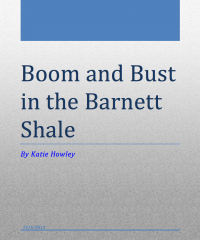
Research Paper:
Paper Subheadings:

Introduction:
Industries that capitalize on non-renewable resources, like hydraulic fracturing, typically go through a boom and bust cycle. This cycle is characterized by fluctuating phases of economic growth and reduction. Booming economies experience increases in gross domestic product and production. Economies during bust periods typically suffer from increased unemployment and drops in production. Following this cycle is an important indicator for the long-term sustainability of the fracking industry. This boom and bust cycle in the Barnett Shale is important to the fracking situation because it is serves as a case study for the industry to learn from. The Barnett Shale is one of the largest shale formations in the United States, located in Texas, that is cultivated for the use of fracking. The industry can identify problems in the economic structure of fracking by looking at this specific example. The fracking industry can use this data to understand why fracking is profitable in the first place and what factors perpetuate the demise of an area with gas exploration. This topic is important for the fracking controversy because it is hard evidence for both sides of the argument. The Boom and Bust in the Barnett Shale exemplifies positive and negative effects of fracking on residents and the local economy. Citizens should be interested in the boom and bust of the Barnett Shale so that they can make an educated decision on whether or not to support fracking and then subsequently take action on that decision. The personal experiences and economic evidence associated with this specific shale should help form informed opinions. An educated public can take action toward whichever side they choose.
